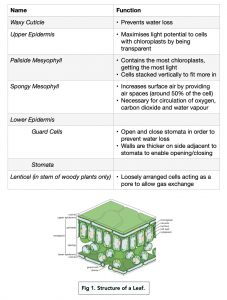Gas Exchange in Plants (A-level Biology)
Gas Exchange in Plants
Gas Exchange in Plant Leaves
There are many layers that make up a plant’s cell, which all serve their own purpose. Below is a table describing their function:

Gas Exchange in Plants
Gas exchange in the leaves occurs through the stomata on the lower epidermis. Most plants, including dicotyledonous plants, use the stoma for gas exchange.
Stoma (singular) are openings which allow for the exchange of carbon dioxide and oxygen. They are opened by ions (mainly K+) which move in via active transport, which allows water loss, something that needs to stay balanced.
Stomata open in response to guard cells bending due to becoming turgid (and uneven thickness in the walls). Water moves in via osmosis due to the water potential being decreased.
Unlike other organisms, plants are reliant on both oxygen and carbon dioxide for processes such as photosynthesis and respiration:
- During photosynthesis, which occurs in most plants during the day (favourable conditions), plants take in carbon dioxide through the open stoma and release oxygen into the environment.
- During respiration, which occurs in most plants at night, plants take in oxygen through the closed stoma and release carbon dioxide into the environment.
- Both carbon dioxide and oxygen enter and exit through the stoma by simple diffusion down their concentration gradients.
Gas exchange in plants refers to the process by which plants take in carbon dioxide and release oxygen through tiny pores called stomata.
Gas exchange is essential for plants as it helps them carry out photosynthesis, which is the process of producing food and energy from light, water, and carbon dioxide.
Gas exchange occurs in plants through tiny pores called stomata, which are found on the leaves. Carbon dioxide enters the plant through the stomata, and oxygen is released.
Stomata play a critical role in gas exchange as they allow carbon dioxide to enter the plant and oxygen to be released. The opening and closing of stomata are regulated by the plant to maintain a balance between the uptake of carbon dioxide and the release of oxygen.
The opening and closing of stomata are influenced by various factors, including light, temperature, and the availability of water. In bright light, stomata open to allow for greater gas exchange, and in low light conditions, they close to conserve water.
The rate of photosynthesis affects gas exchange in plants as it influences the opening and closing of stomata. As the rate of photosynthesis increases, the demand for carbon dioxide also increases, and the stomata open to allow for greater gas exchange.
The main limitations of gas exchange in plants are water availability and temperature. If a plant doesn’t have access to enough water, its stomata will close to conserve water, limiting the exchange of gases. High temperatures can also lead to the closure of stomata to prevent water loss.






Still got a question? Leave a comment
Leave a comment